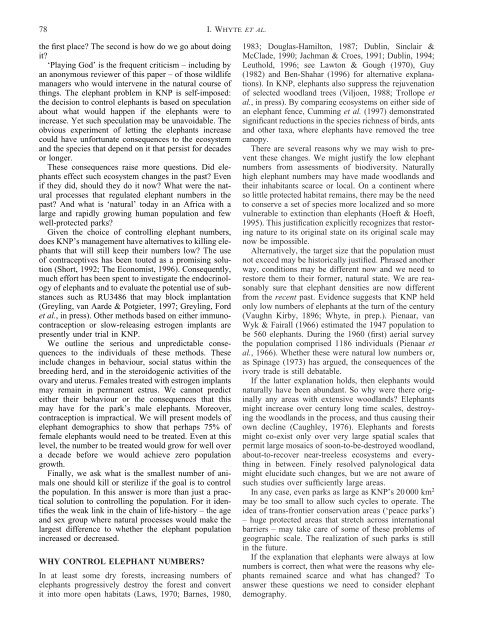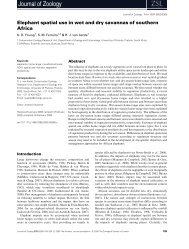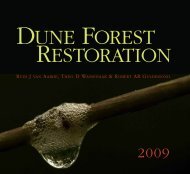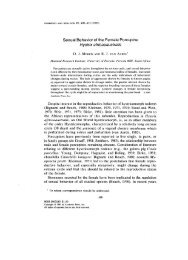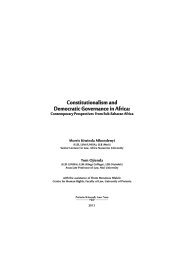Managing the elephants of Kruger National Park - CERU - University ...
Managing the elephants of Kruger National Park - CERU - University ...
Managing the elephants of Kruger National Park - CERU - University ...
Create successful ePaper yourself
Turn your PDF publications into a flip-book with our unique Google optimized e-Paper software.
78 I. WHYTE ET AL.<br />
<strong>the</strong> first place? The second is how do we go about doing<br />
it?<br />
‘Playing God’ is <strong>the</strong> frequent criticism – including by<br />
an anonymous reviewer <strong>of</strong> this paper – <strong>of</strong> those wildlife<br />
managers who would intervene in <strong>the</strong> natural course <strong>of</strong><br />
things. The elephant problem in KNP is self-imposed:<br />
<strong>the</strong> decision to control <strong>elephants</strong> is based on speculation<br />
about what would happen if <strong>the</strong> <strong>elephants</strong> were to<br />
increase. Yet such speculation may be unavoidable. The<br />
obvious experiment <strong>of</strong> letting <strong>the</strong> <strong>elephants</strong> increase<br />
could have unfortunate consequences to <strong>the</strong> ecosystem<br />
and <strong>the</strong> species that depend on it that persist for decades<br />
or longer.<br />
These consequences raise more questions. Did <strong>elephants</strong><br />
effect such ecosystem changes in <strong>the</strong> past? Even<br />
if <strong>the</strong>y did, should <strong>the</strong>y do it now? What were <strong>the</strong> natural<br />
processes that regulated elephant numbers in <strong>the</strong><br />
past? And what is ‘natural’ today in an Africa with a<br />
large and rapidly growing human population and few<br />
well-protected parks?<br />
Given <strong>the</strong> choice <strong>of</strong> controlling elephant numbers,<br />
does KNP’s management have alternatives to killing <strong>elephants</strong><br />
that will still keep <strong>the</strong>ir numbers low? The use<br />
<strong>of</strong> contraceptives has been touted as a promising solution<br />
(Short, 1992; The Economist, 1996). Consequently,<br />
much effort has been spent to investigate <strong>the</strong> endocrinology<br />
<strong>of</strong> <strong>elephants</strong> and to evaluate <strong>the</strong> potential use <strong>of</strong> substances<br />
such as RU3486 that may block implantation<br />
(Greyling, van Aarde & Potgieter, 1997; Greyling, Ford<br />
et al., in press). O<strong>the</strong>r methods based on ei<strong>the</strong>r immunocontraception<br />
or slow-releasing estrogen implants are<br />
presently under trial in KNP.<br />
We outline <strong>the</strong> serious and unpredictable consequences<br />
to <strong>the</strong> individuals <strong>of</strong> <strong>the</strong>se methods. These<br />
include changes in behaviour, social status within <strong>the</strong><br />
breeding herd, and in <strong>the</strong> steroidogenic activities <strong>of</strong> <strong>the</strong><br />
ovary and uterus. Females treated with estrogen implants<br />
may remain in permanent estrus. We cannot predict<br />
ei<strong>the</strong>r <strong>the</strong>ir behaviour or <strong>the</strong> consequences that this<br />
may have for <strong>the</strong> park’s male <strong>elephants</strong>. Moreover,<br />
contraception is impractical. We will present models <strong>of</strong><br />
elephant demographics to show that perhaps 75% <strong>of</strong><br />
female <strong>elephants</strong> would need to be treated. Even at this<br />
level, <strong>the</strong> number to be treated would grow for well over<br />
a decade before we would achieve zero population<br />
growth.<br />
Finally, we ask what is <strong>the</strong> smallest number <strong>of</strong> animals<br />
one should kill or sterilize if <strong>the</strong> goal is to control<br />
<strong>the</strong> population. In this answer is more than just a practical<br />
solution to controlling <strong>the</strong> population. For it identifies<br />
<strong>the</strong> weak link in <strong>the</strong> chain <strong>of</strong> life-history – <strong>the</strong> age<br />
and sex group where natural processes would make <strong>the</strong><br />
largest difference to whe<strong>the</strong>r <strong>the</strong> elephant population<br />
increased or decreased.<br />
WHY CONTROL ELEPHANT NUMBERS?<br />
In at least some dry forests, increasing numbers <strong>of</strong><br />
<strong>elephants</strong> progressively destroy <strong>the</strong> forest and convert<br />
it into more open habitats (Laws, 1970; Barnes, 1980,<br />
1983; Douglas-Hamilton, 1987; Dublin, Sinclair &<br />
McClade, 1990; Jachman & Croes, 1991; Dublin, 1994;<br />
Leuthold, 1996; see Lawton & Gough (1970), Guy<br />
(1982) and Ben-Shahar (1996) for alternative explanations).<br />
In KNP, <strong>elephants</strong> also suppress <strong>the</strong> rejuvenation<br />
<strong>of</strong> selected woodland trees (Viljoen, 1988; Trollope et<br />
al., in press). By comparing ecosystems on ei<strong>the</strong>r side <strong>of</strong><br />
an elephant fence, Cumming et al. (1997) demonstrated<br />
significant reductions in <strong>the</strong> species richness <strong>of</strong> birds, ants<br />
and o<strong>the</strong>r taxa, where <strong>elephants</strong> have removed <strong>the</strong> tree<br />
canopy.<br />
There are several reasons why we may wish to prevent<br />
<strong>the</strong>se changes. We might justify <strong>the</strong> low elephant<br />
numbers from assessments <strong>of</strong> biodiversity. Naturally<br />
high elephant numbers may have made woodlands and<br />
<strong>the</strong>ir inhabitants scarce or local. On a continent where<br />
so little protected habitat remains, <strong>the</strong>re may be <strong>the</strong> need<br />
to conserve a set <strong>of</strong> species more localized and so more<br />
vulnerable to extinction than <strong>elephants</strong> (Hoeft & Hoeft,<br />
1995). This justification explicitly recognizes that restoring<br />
nature to its original state on its original scale may<br />
now be impossible.<br />
Alternatively, <strong>the</strong> target size that <strong>the</strong> population must<br />
not exceed may be historically justified. Phrased ano<strong>the</strong>r<br />
way, conditions may be different now and we need to<br />
restore <strong>the</strong>m to <strong>the</strong>ir former, natural state. We are reasonably<br />
sure that elephant densities are now different<br />
from <strong>the</strong> recent past. Evidence suggests that KNP held<br />
only low numbers <strong>of</strong> <strong>elephants</strong> at <strong>the</strong> turn <strong>of</strong> <strong>the</strong> century<br />
(Vaughn Kirby, 1896; Whyte, in prep.). Pienaar, van<br />
Wyk & Fairall (1966) estimated <strong>the</strong> 1947 population to<br />
be 560 <strong>elephants</strong>. During <strong>the</strong> 1960 (first) aerial survey<br />
<strong>the</strong> population comprised 1186 individuals (Pienaar et<br />
al., 1966). Whe<strong>the</strong>r <strong>the</strong>se were natural low numbers or,<br />
as Spinage (1973) has argued, <strong>the</strong> consequences <strong>of</strong> <strong>the</strong><br />
ivory trade is still debatable.<br />
If <strong>the</strong> latter explanation holds, <strong>the</strong>n <strong>elephants</strong> would<br />
naturally have been abundant. So why were <strong>the</strong>re originally<br />
any areas with extensive woodlands? Elephants<br />
might increase over century long time scales, destroying<br />
<strong>the</strong> woodlands in <strong>the</strong> process, and thus causing <strong>the</strong>ir<br />
own decline (Caughley, 1976). Elephants and forests<br />
might co-exist only over very large spatial scales that<br />
permit large mosaics <strong>of</strong> soon-to-be-destroyed woodland,<br />
about-to-recover near-treeless ecosystems and everything<br />
in between. Finely resolved palynological data<br />
might elucidate such changes, but we are not aware <strong>of</strong><br />
such studies over sufficiently large areas.<br />
In any case, even parks as large as KNP’s 20 000 km 2<br />
may be too small to allow such cycles to operate. The<br />
idea <strong>of</strong> trans-frontier conservation areas (‘peace parks’)<br />
– huge protected areas that stretch across international<br />
barriers – may take care <strong>of</strong> some <strong>of</strong> <strong>the</strong>se problems <strong>of</strong><br />
geographic scale. The realization <strong>of</strong> such parks is still<br />
in <strong>the</strong> future.<br />
If <strong>the</strong> explanation that <strong>elephants</strong> were always at low<br />
numbers is correct, <strong>the</strong>n what were <strong>the</strong> reasons why <strong>elephants</strong><br />
remained scarce and what has changed? To<br />
answer <strong>the</strong>se questions we need to consider elephant<br />
demography.


